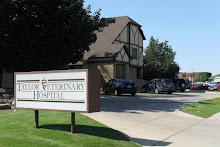 Image via Wikipedia
Image via Wikipedia
If your dog dives under the bed, crawls into the bathtub, or refuses to leave your side when a storm approaches, there is a reason. Storm phobias are one of the most common behavioral problems dog owners face. Some owners are willing to simply put up with symptoms like hiding, trembling, whining, drooling, and pacing, but in more severe cases, panicked dogs may chew furniture, tear drapes, and even break windows during a thunderstorm. In either case, the behaviors displayed are signs of a terrified, unhappy dog.
Behaviorists are not yet sure what part of the storm frightens dogs the most. It may be that they are reacting to lightning flashes, the sound of thunder, wind blowing around the house, or the sound of rain on the roof. Some dogs even start to pace and whine half an hour or more before a storm. They may be acting in response to a rapidly falling barometric pressure or the electrical charge of the air.
An article in the July/August 2001 issue of the Journal of the American Animal Hospital Association describes an Internet survey of the owners of storm-phobic dogs. The authors discovered that some breeds may be predisposed to a fear of storms. Herding dogs, such as collies and German shepherds, and hounds, such as beagles and basset hounds, seem to be more likely to develop a storm phobia than other dogs. The phobia is also common in sporting and working breeds. The study also showed that rescued dogs (dogs adopted from shelters or rescue organizations) may also be more likely to develop storm phobias.
The first step in helping your dog overcome a storm phobia is to talk to your veterinarian. He or she can help you develop a program to gradually retrain your dog by using the behavior modification techniques of desensitization and counter conditioning. These techniques work by exposing the storm-phobic dog to some gentle reminders of a thunderstorm, such as a very soft tape recording of thunder or a flashing light, and then rewarding the dog with lots of treats, attention, and other positive reinforcement only if there's no evidence of anxiety. Over time, the intensity of the stimulus is increased, and it is important to remember that only calm behavior is rewarded. You should get professional guidance, either from a veterinarian or a veterinary behavior specialist, before you begin this process as introducing frightening stimuli too quickly or not recognizing fear in your dog could make the phobia worse.
If behavior modification alone doesn't solve the problem, there are some medications that can help. Your veterinarian can prescribe one of several anti-anxiety or antidepressant medications to help your dog remain calm during storms. It is also beneficial to have a “safe place” for your dog to retreat to when the weather gets scary. This could be a crate or a certain room in the house where your dog feels protected.
The most important thing to remember is to treat your dog gently and kindly when he is afraid. Don't cuddle and reassure him though, because that will reward his “panicked” behavior, but definitely don't punish him for it either. Instead, just be calm and provide him with a safe, familiar place where he can feel secure and ride out the storm.
Chad Smith, D.V.M.
![Reblog this post [with Zemanta]](http://img.zemanta.com/reblog_e.png?x-id=c33a5aa8-a6ed-46ea-a525-a85cd03dcb37)


No comments:
Post a Comment